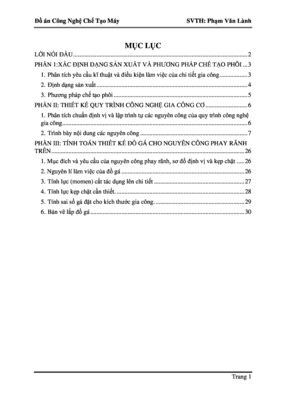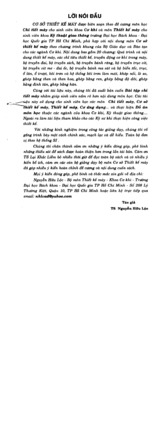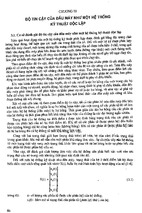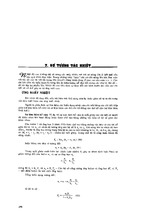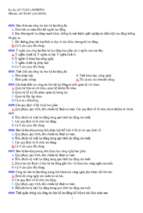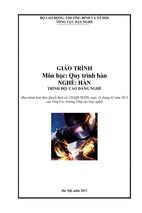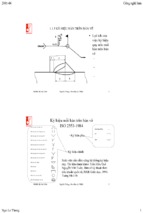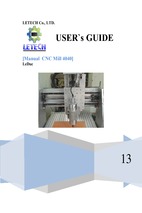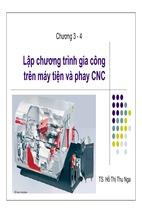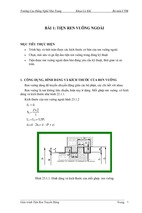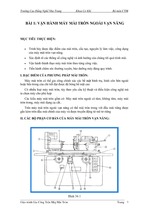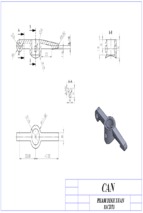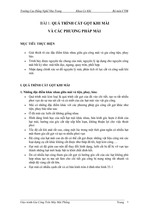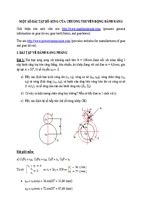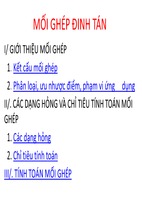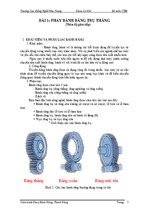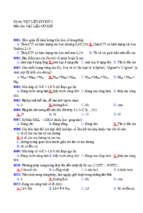,QWURGXFWLRQ
WR
6KRFN� �9LEUDWLRQ
l
Definitions
l
What is Vibration
l
Mechanical Parameters
l
Mass-spring Systems
l
How to Quantify Vibration
l
Signal Types
l
Time Signal Descriptors
l
Conversions:
Acceleration, Velocity, Displacement
l
Units
BA 7674-12, 1
$EVWUDFW
The lecture gives an introduction to vibration through a description of the
most common mechanical parameters leading to the behaviour of simple
mass-spring systems. Furthermore the different types of signals and their
description is treated and the conversion between the different parameters is
described mathematically and graphically. Finally the measurement units are
defined.
Copyright© 1998
Brüel & Kjær Sound and Vibration Measurement A/S
All Rights Reserved
/(&785(�127(
English BA 7674-12
'HILQLWLRQV
9LEUDWLRQ is an oscillation wherein the
quantity is a parameter defining the
motion of a mechanical system
2VFLOODWLRQ is the variation, usually with
time, of the magnitude of a quantity with
respect to a specified reference when the
magnitude is alternately greater and
smaller than the reference
BA 7674-12, 2
'HILQLWLRQV
It is practical to know more precisely what we are going to talk about. These
definitions are adapted from the “Shock and Vibration Handbook” by Harris
and Crede (see literature list).
Page 2
9LEUDWLRQ�,Q�(YHU\GD\�/LIH
�����UH
WU�IJNM�MJ
�����NJ
I�ONGVGã
�
KD�SZZ
SRGM�GH
R
BA 7674-12, 3
:KDW�LV�9LEUDWLRQ"
Vibration is mechanical oscillation about a reference position. Vibration is an
everyday phenomenon, we meet it in our homes, during transport and at
work. Vibration is often a destructive and annoying side effect of a useful
process, but is sometimes generated intentionally to perform a task.
9LEUDWLRQ�RI�PDFKLQHV
Vibration is a result of dynamic forces in machines which have moving parts
and in structures which are connected to the machine. Different parts of the
machine will vibrate with various frequencies and amplitudes. Vibration
causes wear and fatigue. It is often responsible for the ultimate breakdown of
the machine.
Page 3
8VHIXO�9LEUDWLRQ
BA 7674-12, 4
8VHIXO�$SSOLFDWLRQ�RI�9LEUDWLRQ
Vibration is generated intentionally in component feeders, concrete
compactors, ultrasonic cleaning baths and pile drivers, for example. Vibration
testing machines impart vibration to objects in order to test their resistance
and function in vibratory environments.
Page 4
0HFKDQLFDO�3DUDPHWHUV�DQG�&RPSRQHQWV
Displacement
Velocity
Acceleration
m
d
v
k
a
c
F=k×d
F=c×v
m
F=m×a
BA 7674-12, 5
0HFKDQLFDO�3DUDPHWHUV
Before going into a discussion about vibration measurement and analysis,
we will examine the basic mechanical parameters and components and how
they interact.
All mechanical systems contain the three basic components: spring, damper,
and mass. When each of these in turn is exposed to a constant force they
react with a constant displacement, a constant velocity and a constant
acceleration respectively.
Page 5
6LPSOHVW�)RUP�RI�9LEUDWLQJ�6\VWHP
Displacement
d = D sinωnt
Displacement
D
Time
T
Frequency
1
T
m
Period, Tn in [sec]
k
1
Frequency, fn= T in [Hz = 1/sec]
n
ωn= 2 π fn =
k
m
BA 7674-12, 6
0DVV�DQG�6SULQJ
Once a (theoretical) system of a mass and a spring is set in motion it will
continue this motion with constant frequency and amplitude. The system is
said to oscillate with a sinusoidal waveform.
7KH�6LQH�&XUYH
The sine curve which emerges when a mass and a spring oscillate can be
described by its amplitude (D) and period (T). Frequency is defined as the
number of cycles per second and is equal to the reciprocal of the period. By
multiplying the frequency by 2π the angular frequency is obtained, which is
again proportional to the square root of spring constant k divided by mass m.
The frequency of oscillation is called the natural frequency fn. The whole sine
wave can be described by the formula d = Dsin ωnt, where d = instantaneous
displacement and D = peak displacement.
Page 6
)UHH�9LEUDWLRQ
D
Energy transfer between Kinetic and Potential Energy
(assuming no damping)
∆ Kinetic Energy = - ∆ Potential Energy
1/2
1/2
m V2 = 1/2 k D2 , and V = (2πfn)D
m (2πfn)2 D2 = 1/2 k D2
fn =
1
2π
k
m
BA 7674-12, 7
)UHH�XQGDPSHG�YLEUDWLRQ
When a free undamped mass-spring system is set into oscillation the added
energy is constant, but changes form from kinetic to potential during the
motion.
At maximum displacement the velocity and therefore also the kinetic energy
is zero, while the potential energy is 1/2kD2. At the equilibrium position the
potential energy is zero and the kinetic energy is maximum at 1/2mV2.
For the sinusoidal motion
d = D sinωnt
we can also find the velocity by differentiating:
v=
d(Dsinω n t)
= ω nDcosω n t = Vcosω n t
dt
and thereby find V = 2πfnD.
Using energy conservation laws we then get the natural resonance
frequency
fn =
1
2π
Page 7
k
m
0DVV�DQG�6SULQJ
time
m1
k
ωn = 2πIQ =
m + m1
m
Increasing mass
reduces frequency
BA 7674-12, 8
,QFUHDVH�RI�0DVV
An increase in the mass of a vibrating system causes an increase in period
i.e. a decrease in frequency.
Page 8
0DVV��6SULQJ�DQG�'DPSHU
time
Increasing damping
reduces the amplitude
m
k
c1 + c2
BA 7674-12, 9
0DVV��6SULQJ�DQG�'DPSHU
When a damper is added to the system it results in a decrease in amplitude
with time. The frequency of oscillation known as the damped natural
frequency is constant and almost the same as the natural frequency. The
damped natural frequency decreases slightly for an increase in damping.
Page 9
)RUFHG�9LEUDWLRQ
Displacement
P
7L
H
m
dm
k
c
Frequency
dF
F
Magnitude
dm = df
Frequency
Phase
+90°
0°
-90°
Frequency
BA 7674-12, 10
)RUFHG�9LEUDWLRQ
If an external sinusoidal force is applied to the system, the system will follow
the force, which means that the movement of the system will have the same
frequency as the external force. There might, however, be a difference in
amplitude (and phase) as shown in the diagram.
For frequencies below its natural frequency, the amplitude of the vibrating
system will increase as the frequency is increased, a maximum being
reached at the natural frequency. If there was no damping in the system
(c = 0), the amplitude would approach infinity.
If the frequency of the external force is increased the frequency of the
spring/mass/damper system will increase to the same value, but the
amplitude (and the phase) will change in accordance with the curves in the
diagrams.
Page 10
5HVSRQVHV�&RPELQH
Magnitude
1+2
d1+ d2
2
1
Frequency
m
d1
Phase
dF
Frequency
0°
F
1
-90°
2
1+2
-180°
BA 7674-12, 11
&RPELQHG�UHVSRQVHV
When considering real mechanical systems they will normally be more
complex than the previous models. A simple example of two
masses/springs/dampers is shown here.
In this system we will see the responses combined, and its frequency
response function shows two resonance peaks corresponding to the two
masse/spring/damper systems.
Page 11
5HVSRQVH�0RGHOV
Multi Degree of Freedom
MDOF
Single Degree of Freedom
SDOF
F
Magnitude
Magnitude
f0
Frequency
F
Frequency
BA 7674-12, 12
6LQJOH�'HJUHH�RI�)UHHGRP�6\VWHP
A system consisting of only one mass, one spring and one damper is called
a single degree of freedom system (if it can move in one direction only; if this
system also can move sideways it is said to have two degrees of freedom
and the discussion in the following diagram will apply). The phase is normally
ignored in general vibration measurements, but it is very important when
system analysis is made.
0XOWL�'HJUHH�RI�)UHHGRP�6\VWHP
If the mechanical system consist of a number of interacting masses, springs
and dampers or it can move in more than one direction, it is called a multidegree of freedom system and the frequency spectrum will have one peak
for each degree of freedom. Most systems are multi-degree of freedom
systems, although it can often be difficult to separate the different mechanical
components and even more difficult to design models as simple as this!
Page 12
³5HDO�ZRUOG´�5HVSRQVH
Magnitude
Rotor
Bearing
Bearing
Foundation
Frequency
BA 7674-12, 13
5HDO�ZRUOG�5HVSRQVH
In most cases even simple systems are to be considered multi degree of
freedom systems as illustrated here by a simple rotor in a couple of bearings.
Page 13
)RUFHV�DQG�9LEUDWLRQ
Input
Forces
+
System
Response
(Mobility)
+
Frequency
)RUFHV�FDXVHG�E\
l Imbalance
l Shock
l Friction
l Acoustic
=
Vibration
=
Frequency
6WUXFWXUDO
3DUDPHWHUV:
l Mass
l Stiffness
l Damping
Frequency
9LEUDWLRQ
3DUDPHWHUV�
l Acceleration
l Velocity
l Displacement
BA 7674-12, 14 891875
)RUFHV�DQG�YLEUDWLRQ
A system will respond to an input force with a certain motion, depending on
what we call the mobility of the system. Knowing the force and the mobility
permits us to calculate the vibration.
Modal analysis or other methods are used to model systems. Once the
model is created we can calculate its mobility for a force input at a certain
point, and thereby predict vibration at different locations. Such models can
also in some cases be used to calculate the load on the structure to predict
failure.
Page 14
:K\�'R�:H�0HDVXUH�9LEUDWLRQ"
l
l
To verify that frequencies and
amplitudes do not exceed the
material limits (e.g. as described by
the Wöhler curves)
To avoid excitation of resonances in
certain parts of a machine
l
To be able to dampen or isolate
vibration sources
l
To make conditional
maintenance on machines
l
To construct or verify computer
models of structures (system
analysis)
BA 7674-12, 15
:K\�PHDVXUH�YLEUDWLRQ"
A number of reasons are listed here.
The Wöhler curve is a curve describing the stress level up to which a
structure can be loaded a certain number of times (endurance strength). At
high stresses the load can only be carried a few times, but reducing the
stress increases the number of cycles to failure. For most metals there exists
an endurance limit for which the endurance becomes infinite. This stress
level is very important, and it is often found by subjecting the object to
10.000.000 cycles of stress, based on the experience that this number is
sufficient to reach the endurance limit.
Page 15
+RZ�GR�:H�4XDQWLI\�9LEUDWLRQ"
l
We make a measurement
l
We analyse the results (levels and frequencies)
In order to make the analysis, we must first talk
about the types of vibration signals we might
encounter and how we measure these signals
BA 7674-12, 16
Page 16
7\SHV�RI�6LJQDOV
Stationary signals
Deterministic
Non-stationary signals
Random
Continuous
Transient
BA 7674-12, 17
6LJQDOV
Basically a distinction between Stationary Signals and Non-stationary
Signals has to be made. Stationary Signals can again be divided into
Deterministic Signals and Random Signals, and Non-stationary Signals into
Continuous and Transient signals.
Stationary deterministic signals are made up entirely of sinusoidal
components at discrete frequencies.
Random signals are characterised by being signals where the instantaneous
value cannot be predicted, but where the values can be characterised by a
certain probability density function i.e. we can measure its average value.
Random signals have a frequency spectrum which is continuously distributed
with frequency.
The continuous non-stationary signal has some similarities with both
transient and stationary signals. During analysis continuous non-stationary
signals should normally be treated as random signals or separated into the
individual transient and treated as transients.
Transient signals are defined as signals which commence and finish at a
constant level, normally zero, within the analysis time.
Page 17
'HWHUPLQLVWLF�6LJQDOV
B
C
Amplitude
Amplitude
A
A
B
CD
E
Time
E
Frequency
Vibration
D
BA 7674-12, 18
'HWHUPLQLVWLF�6LJQDOV
The vibration signal from a gearbox could look like the one shown here. In
the frequency domain this signal will give rise to a number of separate peaks
(discrete frequency components) which through knowledge of the number of
teeth on the gearwheels and their speed can be related back to particular
parts of the system. The signal here is called deterministic, since the
instantaneous value of the signal is predictable at all points in time.
7KH�UROH�RI�IUHTXHQF\�DQDO\VLV
The frequency spectrum gives in many cases a detailed information about
the signal sources which cannot be obtained from the time signal. The
example shows measurement and frequency analysis of the vibration signal
measured on a gearbox. The frequency spectrum gives information on the
vibration level caused by rotating parts and tooth meshing. It hereby
becomes a valuable aid in locating sources of increased (undesirable)
vibration from these and other sources.
Page 18
'HWHUPLQLVWLF�6LJQDOV�DQG�+DUPRQLFV
Time
f1
2f1 Frequency
f1
Frequency
Time
Time
2f1 Frequency
BA 7674-12, 19
9LEUDWLRQ�6LJQDOV
The motion of a mechanical system can consist of a single component at a
single frequency as with the system described in one of the previous
examples; (a tuning fork is another example) or it can consist of several
components occurring at different frequencies simultaneously, as for
example with the piston motion of an internal combustion engine.
The motion signal is here split up into its separate components both in the
time domain and in the frequency domain.
Page 19
+DUPRQLFV
Generator
Time
f0
3f1
5f1 Frequency
Time
f0 2f0 3f0 4f0 5f0 Frequency
BA 7674-12, 20
+DUPRQLFV
Many non-sinusoidal signals can be separated into a number of harmonically
related sinusoids. Two examples are given. The harmonic components are
always referred to the fundamental frequency to which they are related.
Page 20
- Xem thêm -


